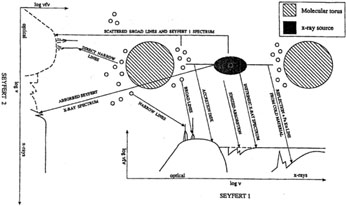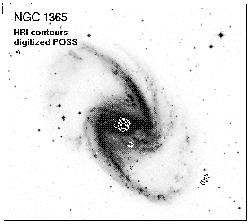


4.2. X-Ray Sources
Strong X-ray emission is very common in active galactic nuclei and an
important property of these objects (see the review by
Mushotzky et al. 1993).
A large fraction of the luminosity is actually radiated in the
X-ray domain and the fast variation of the X-ray flux shows that it
must originate in a small region very close to the central object - in
the X-ray domain we reach deep into the active nucleus. The dominating
component in the 2 - 50 keV energy range of the X-ray spectra of
Seyfert 1 galaxies can be described by a power law F(E) ~
E- , where
E is the energy and the photon index
, where
E is the energy and the photon index
 is
close to 1.7. This power law continuum is affected by absorption at
lower energies due to partially ionized or neutral material in the line
of sight. In addition, broad and asymmetric neutral Fe-K emission lines
with a rest frame energy of 6.40 keV are common in X-ray spectra of
Seyfert galaxies. These lines have been suggested to originate in an
accretion disk around a nuclear black hole, the line profiles beeing
affected by Doppler shifts due to rotation and gravitational redshift.
A sketch of the unified model of an AGN and the contributions to its
spectrum as drawn by
Mushotzky et al. (1993)
is reproduced in
Fig. 17. Seyfert 1 galaxies, where the nucleus
is seen directly, are generally
strong X-ray sources with a variable continuum. Seyfert 2's have
X-ray luminosities two or more magnitudes smaller, supposedly due to
obscuration, and where the soft X-rays are considered to be scattered
nuclear X-rays. Low luminosity AGNs with 2 - 10 keV luminosities of
1040-41 erg s-1 have been found in several nearby spiral
galaxies (for references see
Iyomoto et al. 1997).
is
close to 1.7. This power law continuum is affected by absorption at
lower energies due to partially ionized or neutral material in the line
of sight. In addition, broad and asymmetric neutral Fe-K emission lines
with a rest frame energy of 6.40 keV are common in X-ray spectra of
Seyfert galaxies. These lines have been suggested to originate in an
accretion disk around a nuclear black hole, the line profiles beeing
affected by Doppler shifts due to rotation and gravitational redshift.
A sketch of the unified model of an AGN and the contributions to its
spectrum as drawn by
Mushotzky et al. (1993)
is reproduced in
Fig. 17. Seyfert 1 galaxies, where the nucleus
is seen directly, are generally
strong X-ray sources with a variable continuum. Seyfert 2's have
X-ray luminosities two or more magnitudes smaller, supposedly due to
obscuration, and where the soft X-rays are considered to be scattered
nuclear X-rays. Low luminosity AGNs with 2 - 10 keV luminosities of
1040-41 erg s-1 have been found in several nearby spiral
galaxies (for references see
Iyomoto et al. 1997).

|
Figure 17. Sketch of the unified model of an active galactic nucleus (AGN) and the contributions to its spectrum. From Mushotzky et al. (1993). |
NGC 1365 was detected as an extended X-ray source at a 0.2 - 4.0 keV luminosity of 8.8 x 1040 erg s-1 by the Einstein Observatory satellite (Maccacaro et al. 1982; Fabbiano et al. 1992; see also Iyomoto et al. 1997). The galaxy was observed with the ROSAT satellite in the 0.1 - 2.0 keV soft X-ray domain by Turner et al. (1993), using the Position Sensitive Proportional Counter (PSPC) with a spatial resolution of 25" (FWHM). In addition to the central source five `serendipitous' sources were found within the optical image of the galaxy. In view of the extended activity in the form of star forming regions, compact super clusters, compact radio sources and even radio supernovae within 10" from the nucleus, the soft X-ray emission from the nuclear region may arise from other origins than the AGN itself.
Of the five serendipitous sources within the optical extent of the galaxy, four lie in, or very close to, the prominent main spiral arms. Due to the position uncertainty it is difficult to connect them to any specific of the numerous H II regions along the arms. Two of the sources (companions 1 and 2) seemed to be strongly variable. Turner et al. do not find any specific optical identification and conclude that the sources most probably are X-ray binaries in NGC 1365. It may be worthwhile to note that companion 4 falls within about 14" from the position of the supernova SN 1957C. Of course, this may not mean more than that the X-ray source and the supernova are formed in the same complex of star forming regions in the spiral arm. Roy and Walsh (1988) have mapped this part of the NW spiral arm by optical imaging spectroscopy.
NGC 1365 was observed by ASCA, an X-ray satellite capable of simultaneous imaging and spectroscopy over the energy range 0.5 - 10 keV (Tanaka et al. 1994), at two occasions with an interval of 166 days by Iyomoto et al. (1997). The energy range of the Solid State Imaging Spectrometer (SIS) was 0.6 - 7.0 keV. In the second observation an extra source about 1'.5 south of the nucleus was seen in addition to the nuclear source. This second source coincides within 1'.0 with companion 5 of Turner et al. Both the nuclear and the secondary source are point-like with an upper limit of the angular extent of 0'.2.
Spectra were obtained by Iyomoto et al. with the SIS for the nuclear and the secondary sources separately. The spectrum of the nucleus shows a strong Fe-K emission line at 6.6 keV and was fitted by a model with three components:
The secondary X-ray source was detected only at the second observing
run and thus should be strongly variable. There is no trace of the Fe-K
line in the spectrum of this source. Its spectrum was fitted with a
power-law with a photon index  = 1.7, and, assuming that the
source belongs to the galaxy, a 2-10 keV luminosity LX = 3.8
x 1040 ergs s-1. Considering its point-like image and
strong variability, Iyomoto et al. find it likely to be an
ultra-luminous point source belonging to NGC 1365.
= 1.7, and, assuming that the
source belongs to the galaxy, a 2-10 keV luminosity LX = 3.8
x 1040 ergs s-1. Considering its point-like image and
strong variability, Iyomoto et al. find it likely to be an
ultra-luminous point source belonging to NGC 1365.
Further X-ray observations of NGC 1365 with the ROSAT PSPC and the High Resolution Imager (HRI) were analyzed by Komossa and Schulz (1998a, b). Their HRI map is shown in Fig. 18 as an overlay on an image of the galaxy. Of several models tried for the central source they favour a two-component model with about equal contributions from a power-law source and a thermal plasma. They find difficulties to combine the strong BLR component and weak X-ray emission with the simplest version of the unified model for AGNs where only the torus blocks the light but the observation of the BLR implies an unobscured view of the X-ray source.

|
Figure 18. X-ray contours as observed with the High Resolution Imager on the ROSAT satellite overlaid on an optical image of NGC 1365. The source south of the nuclear source, located in a subordinate spiral arm, is NGC 1365-X1. The source far out to the SW is companion 2 of Turner et al. (1993). From Komossa & Schulz (1998a). |
Among the surrounding X-ray sources they in particular analyze the strongly variable secondary source (RX J0333 -3609) of Iyomoto et al. (1997) which they name NGC 1365-X1. This source has a position
with respect to the nucleus and coincides within 15" with
companion 5 of Turner et al. It is centered on one of the secondary
spiral arms within the main body of the galaxy and is one of the most
luminous and most highly variable off-nuclear X-ray sources known. It
is highly variable on the time scale of months. Komossa and Schulz
suggest as the most likely interpretation that the source is an
ultra-powerful X-ray binary where one component is either a massive
black hole (~ 100 - 200
M
 cos
cos  = -22".6;
= -22".6;

 = -72".8
= -72".8
 ) or a low-mass black
hole with a luminosity vastly larger than the Eddington luminosity.
) or a low-mass black
hole with a luminosity vastly larger than the Eddington luminosity.